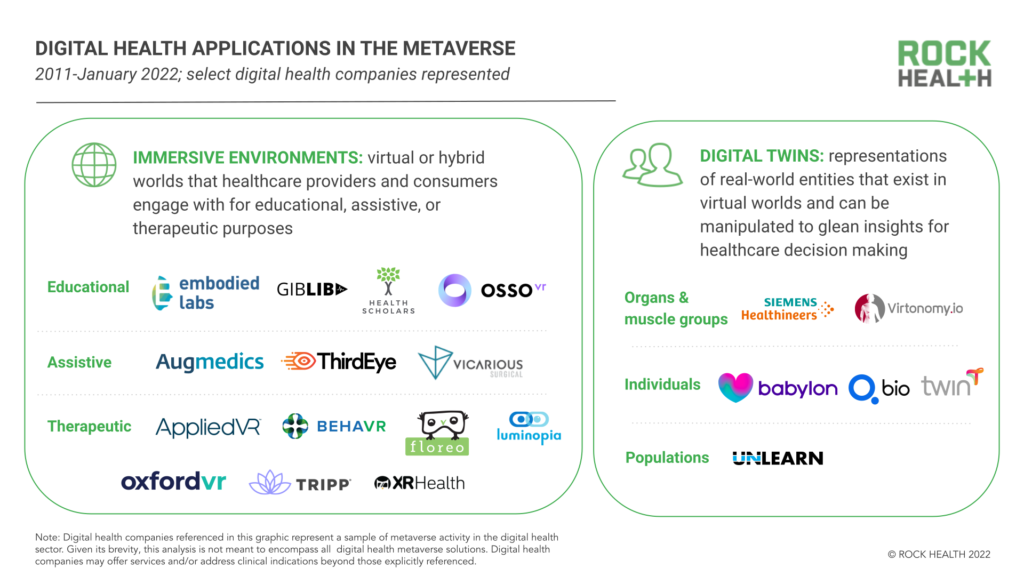Digital health enters the metaverse
Unless you’re living under a real-life rock, you’ve likely heard that Facebook, Microsoft, and Walmart are all making land grabs for the metaverse, a domain of the internet where individuals engage with or immerse themselves within virtual worlds with the help of digital tools. While the concept of the metaverse has been around for decades, Facebook’s name change to Meta propelled the topic into headlines, and business leaders are taking notice too.
While metaverse trends related to gaming and art may feel miles away from healthcare, today’s metaverse leaders are also making health moves. So does digital health have a place in virtual worlds? Turns out, digital health startups have already entered the metaverse, with some implications in tow.
What’s the metaverse?
For our purposes, let’s explain the metaverse in the context of the digital health landscape. Currently, digital health is dominated by products and solutions that give patients and providers the ability to view, share, exchange, create, or otherwise interact with digital content. Examples include entering patient data into EHRs, sending payments through online portals, watching physical therapy demonstrations on an app, or sharing video during a telemedicine consult.
However, to paraphrase Zuck, the metaverse changes the relationship between people and technology, allowing users to experience themselves within or alongside virtual content, rather than simply interacting with digital products and solutions. Digital health metaverse experiences might include patients attending virtual reality (VR) group therapy sessions, surgeons planning out procedures on anatomical holograms, or expectant mothers practicing breastfeeding techniques in augmented reality (AR).
Digital health’s metaverse funding and landscape
Metaverse technologies aren’t common in digital health just yet, but we’re seeing early signals of investment and innovation. 2021’s investors shelled out $198M in funding for U.S. digital health startups integrating VR or AR technologies across 11 deals, more than double the $93M raised across eight deals in 2020. However, 2021’s $198M investment was less than 1% of the year’s digital health funding total, reinforcing the infancy of metaverse technologies within the sector. These funding trends mirror growing regulatory activity in the space. The FDA, which hosts its own medical extended reality program, cleared metaverse solutions from AppliedVR, PrecisionOS, and Luminopia in 2021.
At Rock Health, we believe healthcare isn’t destined to be virtual-only; instead, we’re banking on a future of digital and in-person touchpoints to strike the right balance of accessible, high-value care. But we do see some components of healthcare thriving in virtual worlds, with a few startups already leading the charge. While there’s a wide range of possibility for healthcare in the metaverse, we’ll focus on today’s two most common categories of metaverse applications in digital health1:
- Immersive environments: virtual or hybrid worlds that healthcare providers and consumers engage with for educational, assistive, or therapeutic purposes
- Digital twins: representations of real-world entities that exist in virtual worlds and can be manipulated to glean insights for healthcare decision making

Immersive environments
The biggest category of digital health startups in the metaverse offer providers and consumers access to virtual or mixed reality worlds. These immersive environments can be fully virtual and accessed through VR, or a hybrid of real-world and digital components that come together via AR technology or holograms.
Today’s immersive environments in digital health serve educational, assistive, and therapeutic purposes. On the education front, startups2 include digital medical library with VR content Giblib and surgical training platform Osso VR. Health Scholars immerses clinicians in emergency situations to practice rapid response, while Embodied Labs helps caregivers empathize with patients’ conditions.
Beyond education, immersive environments can assist clinicians as they plan or complete procedures. Vicarious Surgical outfits surgeons with VR headsets to control minimally-invasive surgical robots, while Augmedics’s AR navigation system helps orthopedic surgeons place implants. Outside of the OR, metaverse solutions can help scale the reach of trained clinicians. ThirdEye’s AR glasses for first responders enable clinicians to evaluate a patient’s condition and provide care instructions before they arrive at the hospital.
Metaverse experiences can also be used by patients to receive or amplify treatments. One value add of these immersive environments can heighten the intensity of patients’ therapeutic experiences. Heightened experiences draw consumers to meditation metaverses BehaVR and Tripp and differentiate AppliedVR’s and XRHealth’s treatments for chronic pain.
Additionally, therapeutic metaverse environments can scale access to the specialized settings required for certain care interventions. For example, metaverse startup OxfordVR enables patients to try exposure therapy in virtual spaces to address phobias and PTSD, Floreo lets children with autism spectrum disorder practice behavioral skills in different social contexts, and Luminopia generates digital scenes to treat neuro-visual disorders like amblyopia. We expect to see more metaverse innovation in clinical areas that rely heavily on interaction with one’s environment—developmental disorder support, neurological rehabilitation, and MSK care, to name a few.
Digital twins
Another class of digital health metaverse startups are creating digital twins: representations of real-world entities (e.g., organs, individuals, patient populations) that exist in virtual worlds and can be manipulated to glean insights for healthcare decision making. Digital twins are a form of synthetic data, the broad class of artificially-generated information used in place of real-world data. However, unlike other forms of synthetic data, digital twins are modeled off of real entities and are often connected in an ongoing manner to their real-world counterparts. This hybrid connection places digital twins squarely in the metaverse.
One form of healthcare digital twins are those of organs and muscle groups. Siemens Healthineers is pioneering cardiac digital twins, complex digital simulations that reflect the molecular structure and biological function of individual patients’ hearts. Using cardiac digital twins, doctors can simulate how a patient’s heart would respond to medications, surgeries, or catheter interventions before making any real-world decisions. Similarly, Virtonomy builds digital twins of bone and muscle groups to simulate how medical devices or implants might degrade within a patient’s body over time.
Beyond organs, startups are also creating whole-body digital twins of individuals. Q Bio’s Gemini platform combines patient vitals, scans, medical history, and genetic test results to create complex simulations of whole-patient anatomy and physiology, which consumers can access on a virtual dashboard and share with specialists, trainers, nutritionists, and researchers for individualized care. Consumers’ twins update whenever new test labs or scans are shared. Babylon Health offers a similar digital twin dashboard for patients, while Twin Health develops digital twins focused on metabolism, which individuals and their providers use to plan out lifestyle changes that could help prevent or reverse metabolic disease.
On a larger scale, digital twins can also simulate how populations might respond to disease outbreaks or new drugs, paving the way for clinical trials in the metaverse. For example, Unlearn incorporates prognostic information from multiple patients’ digital twins into randomized controlled studies. Because they reduce the need for intrusive and onsite monitoring, we’re intrigued by the promise that digital twins hold for longitudinal studies on chronic conditions such as longhaul COVID.
What comes next for digital health in the metaverse?
While it’s safe to say that the team at Rock Health hasn’t gone full RollerCoaster Tycoon on the metaverse just yet, we expect that its use cases in digital health will only continue to improve. We’re especially excited by the metaverse’s potential to reduce burden on patients’ real lives, whether by scaling access to therapeutic environments or by simulating possibilities before making care decisions. We also wonder how these solutions might deepen connections in virtual communities, break down isolation barriers for seniors and people with disabilities, and make it easier for individuals to participate in research.
However, like all new technologies, the metaverse brings its own hurdles. Metaverse applications stand to compound health inequities related to device ownership, digital literacy, and internet accessibility, and virtual entities like digital twins raise new questions about how we define patient data and privacy. Plus, health providers and enterprises will need convincing to jump into the metaverse, especially when there are cheaper hardware and software tools in market.
For now, the metaverse remains a brave new world for healthcare innovation, and we’re probably only at the first stage of its hype cycle. For first movers, we’ll be watching to see how you navigate onboarding, workflow integration, and reimbursement for metaverse applications, especially for provider- and patient-facing applications. As with any evolving technology impacting patient outcomes, there are virtually endless possibilities.
Rock Health’s venture fund continues to invest in entrepreneurs bringing unique and innovative technology to healthcare. We would love to hear from you. Get in touch!
Rock Health Advisory provides guidance on digital health strategy, access to proprietary funding databases, and in-depth perspectives on the digital health market. For digital health insights targeted to your needs, drop us a note.
Finally, stay up to date with the latest headlines in healthcare technology and Rock Health news by subscribing to the Rock Weekly.
Footnotes
- Digital health companies and solutions mentioned in this blog post represent a sample of metaverse activity in the digital health sector. Given the brevity of this piece, its analysis is not meant to encompass all digital health metaverse solutions.
- Digital health companies mentioned in this blog post may offer services and/or address clinical indications beyond those explicitly referenced.

